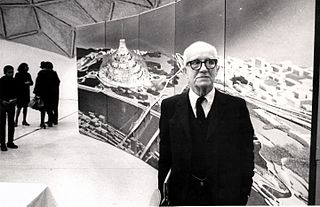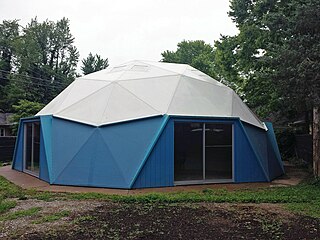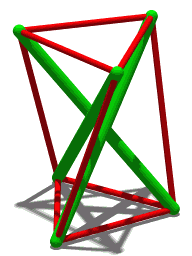 W
WRichard Buckminster Fuller was an American architect, systems theorist, author, designer, inventor, and futurist. He styled his name as R. Buckminster Fuller in his writings, publishing more than 30 books and coining or popularizing such terms as "Spaceship Earth", "Dymaxion", "ephemeralization", "synergetics", and "tensegrity".
 W
WThe Buckminster Fuller Challenge is an annual international design competition that awards $100,000 to the most comprehensive solution to a pressing global problem. The Challenge was launched in 2007 and is a program of The Buckminster Fuller Institute. The competition, open to designers, artists, architects, students, environmentalists, and organizations world-wide, has been dubbed "Socially-Responsible Design's Highest Award" by Metropolis Magazine.
 W
WCloud Nine is the name Buckminster Fuller gave to his proposed airborne habitats created from giant geodesic spheres, which might be made to levitate by slightly heating the air inside above the ambient temperature.
 W
WDymaxion is a term that Buckminster Fuller associated with much of his work—prominently his Dymaxion house and Dymaxion car. Dymaxion, a portmanteau of the words dynamic, maximum, and tension; sums up the goal of his study, "maximum gain of advantage from minimal energy input."
 W
WThe Dymaxion car was designed by American inventor Buckminster Fuller during the Great Depression and featured prominently at Chicago's 1933/1934 World's Fair. Fuller built three experimental prototypes with naval architect Starling Burgess – using donated money as well as a family inheritance – to explore not an automobile per se, but the 'ground-taxiing phase' of a vehicle that might one day be designed to fly, land and drive – an "Omni-Medium Transport". Fuller associated the word Dymaxion with much of his work, a portmanteau of the words dynamic, maximum, and tension, to summarize his goal to do more with less.
 W
WA Dymaxion deployment unit (DDU) or Dymaxion House, is a structure designed in 1940 by Buckminster Fuller consisting of a 20-foot circular hut constructed of corrugated steel looking much like a yurt or the top of a metal silo. The interior was insulated and finished with wallboard, portholes and a door. The dome-like ceiling has a hole in the top and a cap for ventilation.
 W
WThe Dymaxion House was developed by inventor and architect Buckminster Fuller to address several perceived shortcomings with existing homebuilding techniques. Fuller designed several versions of the house at different times — all of them factory manufactured kits, assembled on site, intended to be suitable for any site or environment and to use resources efficiently. A key design consideration of the design was ease of shipment and assembly.
 W
WThe Dymaxion map or Fuller map is a projection of a world map onto the surface of an icosahedron, which can be unfolded and flattened to two dimensions. The flat map is heavily interrupted in order to preserve shapes and sizes.
 W
WAllegra Fuller Snyder is an American dance ethnologist (ethnochoreologist), choreographer, professor and author specializing on dance and culture. Her research focuses on dances among Native American nations, particularly the Yaqui, and on dance among several ethnic groups in Africa and Asia. She is Professor Emerita of dance ethnology from the University of California at Los Angeles (UCLA).
 W
WA geodesic dome is a hemispherical thin-shell structure (lattice-shell) based on a geodesic polyhedron. The triangular elements of the dome are structurally rigid and distribute the structural stress throughout the structure, making geodesic domes able to withstand very heavy loads for their size.
 W
WThe Last Dymaxion: Buckminster Fuller’s Dream Restored is a 2012 documentary film directed by Noel Murphy. about Buckminster Fuller's 1933 Dymaxion car as well as Fuller himself.
 W
WThe Biosphere, also known as the Montreal Biosphere, is a museum dedicated to the environment in Montreal, Quebec, Canada. It is housed in the former United States pavilion constructed for Expo 67 located within the grounds of Parc Jean-Drapeau on Saint Helen's Island. The museum's geodesic dome was designed by Buckminster Fuller.
 W
WThe Old Man River's City project was an architectural design created by Buckminster Fuller in 1971. Fuller was asked to design the structure by the city of East St. Louis. Old Man River's City would have been a truly massive housing project for the city's 70,000 residents. The total capacity of the building, a circular multi-terraced dome, would be 125,000 occupants. Each family would have approximately 2,500 square feet (230 m2) of living space.I originally came to East St. Louis to discuss the design and possible realization of the Old Man River's City, having been asked to do so by East St. Louis community leaders themselves ... It is moon-crater-shaped: the crater's truncated cone top opening is a half-mile in diameter, rim-to-rim, while the truncated mountain itself is a mile in diameter at its base ring. The city has a one-mile -diameter geodesic, quarter-sphere transparent umbrella mounted high above it to permit full, all-around viewing below the umbrella's bottom perimeter. The top of the dome roof is 1,000 feet (300 m) high. The bottom rim of the umbrella dome is 500 feet (150 m) above the surrounding terrain, while the crater-top esplanade, looks 250 feet (76 m) radially inward from the umbrella's bottom, is at the same 500-foot (150 m) height. From the esplanade the truncated mountain cone slopes downwardly, inward and outward, to ground level 500 feet (150 m) below. The moon crater's inward and outward, exterior-surface slopes each consist of fifty terraces - the terrace floors are tiered vertically ten feet above or below one another. All the inwardly, downwardly sloping sides of the moon crater's terraced cone are used for communal life; its outward-sloping, tree-planted terraces are entirely for private life dwelling.
 W
WA proposed domed stadium for the Brooklyn Dodgers, designed by Buckminster Fuller, was to replace Ebbets Field for the Brooklyn Dodgers to allow them to stay in New York City. The Dodgers instead moved to Chavez Ravine in Los Angeles. First announced in the early 1950s, the envisioned structure would have seated 52,000 people and been the first domed stadium in the world, opening roughly a decade before Houston's Astrodome. The stadium, in Fort Greene, Brooklyn, would have been located at the northeast corner of Flatbush Avenue and Atlantic Avenue, on the site of the Atlantic Terminal. It would have cost $6 million to build and been privately financed. It was never built.
 W
WThe R. Buckminster Fuller and Anne Hewlett Dome Home, located at 407 S. Forest Ave. in Carbondale, Illinois, is a geodesic dome house which was the residence of Buckminster Fuller from 1960 to 1971. The house, inhabited by Fuller while he taught at Southern Illinois University, was the only geodesic dome Fuller lived in as well as the only property he ever owned. Fuller, a prolific architect and engineer, popularized the geodesic dome as a building design, and his house was one of the first geodesic dome residences to be constructed. The home was built and designed by Al Miller of the Pease Woodworking Company. While living in the home, Fuller was awarded nine patents, published eleven books, and designed the Montreal Biosphère, one of his most famous works.
 W
WSpaceship Earth is a worldview encouraging everyone on Earth to act as a harmonious crew working toward the greater good.
 W
WTensegrity, tensional integrity or floating compression is a structural principle based on a system of isolated components under compression inside a network of continuous tension, and arranged in such a way that the compressed members do not touch each other while the prestressed tensioned members delineate the system spatially.